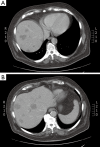Non-operative therapies for colorectal liver metastases
- PMID: 25830041
- PMCID: PMC4311101
- DOI: 10.3978/j.issn.2078-6891.2014.065
Non-operative therapies for colorectal liver metastases
Abstract
Locoregional therapies for colorectal liver metastases complement systemic therapy by providing an opportunity for local control of hepatic spread. The armamentarium for liver-directed therapy includes ablative therapies, embolization, and stereotactic body radiation therapy. At this time, prospective studies comparing these modalities are limited and decision-making relies on a multidisciplinary approach for optimal patient management. Herein, we describe multiple therapeutic non-surgical procedures and an overview of the results of these treatments.
Keywords: Colon cancer; ablation; embolization; liver metastases; radiation.
Figures







References
-
- Köhne CH, Lenz HJ. Chemotherapy with targeted agents for the treatment of metastatic colorectal cancer. Oncologist 2009;14:478-88. - PubMed
-
- Tabernero J, Van Cutsem E, Lakomý R, et al. Aflibercept versus placebo in combination with fluorouracil, leucovorin and irinotecan in the treatment of previously treated metastatic colorectal cancer: prespecified subgroup analyses from the VELOUR trial. Eur J Cancer 2014;50:320-31. - PubMed
-
- Peeters M, Price TJ, Cervantes A, et al. Final results from a randomized phase 3 study of FOLFIRI {+/-} panitumumab for second-line treatment of metastatic colorectal cancer. Ann Oncol 2014;25:107-16. - PubMed
Publication types
LinkOut - more resources
Full Text Sources
Medical
